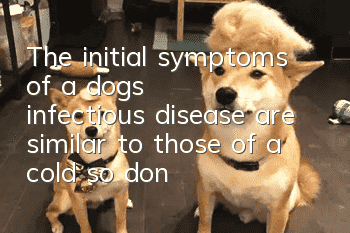The initial symptoms of a dog’s infectious disease are similar to those of a cold, so don’t misjudge it!

The early symptoms of many infectious diseases in dogs are very similar to the symptoms of colds, such as the early symptoms of warm dogs, the early symptoms of parvovirus, etc. The symptoms of these diseases are mainly symptoms such as elevated body temperature, sneezing, blurry eyes, and watery nose, which are very similar to cold symptoms. Some owners are easily confused and mistakenly believe that their dogs have a cold, resulting in misdiagnosis and wrong treatment measures, leading to serious consequences such as the death of their dogs.
False colds are generally more common in the early stages of infectious diseases. In fact, there are other special symptoms. When a dog is infected with the dog warm virus and becomes ill, the body temperature is generally bidirectional, with the body temperature rising and falling. Most sick dogs have symptoms of eye droppings. In the early stage of parvovirus, it is mainly accompanied by major symptoms such as vomiting and diarrhea, and usually vomiting first and then diarrhea. As long as the owner can observe carefully, he can still distinguish and judge. No matter what, when your dog has cold symptoms, you must take timely measures. Inexperienced owners should send their dogs to the doctor promptly to avoid serious consequences! Article source: Pet Information Service Center public account
Cold symptoms in dogs are easy to identify, but they can sometimes be confused. There are two types of colds in dogs. One usually occurs in early spring, late autumn and when the climate changes suddenly. Most of the causes are due to sudden cold stimulation, such as being exposed to strong winds in winter or being hit by drafts when sleeping indoors, sleeping outdoors in cold seasons, being exposed to rain, not drying the dog's coat in time after bathing, etc. The main symptoms of a cold are: the sick dog is depressed, has loss of appetite or has no appetite, flushed conjunctiva, and the eyes are shy and watery. There is a cough, pus-like nasal discharge, accelerated breathing, elevated body temperature, chills and tremors. If not treated in time, it may be complicated by other diseases such as tracheitis and bronchitis. There is also influenza, which is caused by a virus and occurs in epidemic form. The main manifestation is high fever, which in addition to cold symptoms is often accompanied by conjunctivitis and intestinal catarrh.
- Red dog nutrition cream has many side effects
- Golden Retriever training should start from an early age
- Canine distemper incubation period
- Purebred Husky Characteristics
- Can dogs eat raw broccoli?
- Dog sleeping characteristics
- Symptoms of overdose of external anthelmintics in dogs
- How to solve dog’s smelly mouth, dog’s smelly mouth
- How long will it take for a dog to die if it swallows a fishhook?
- What's going on when a dog vomits dog food?



